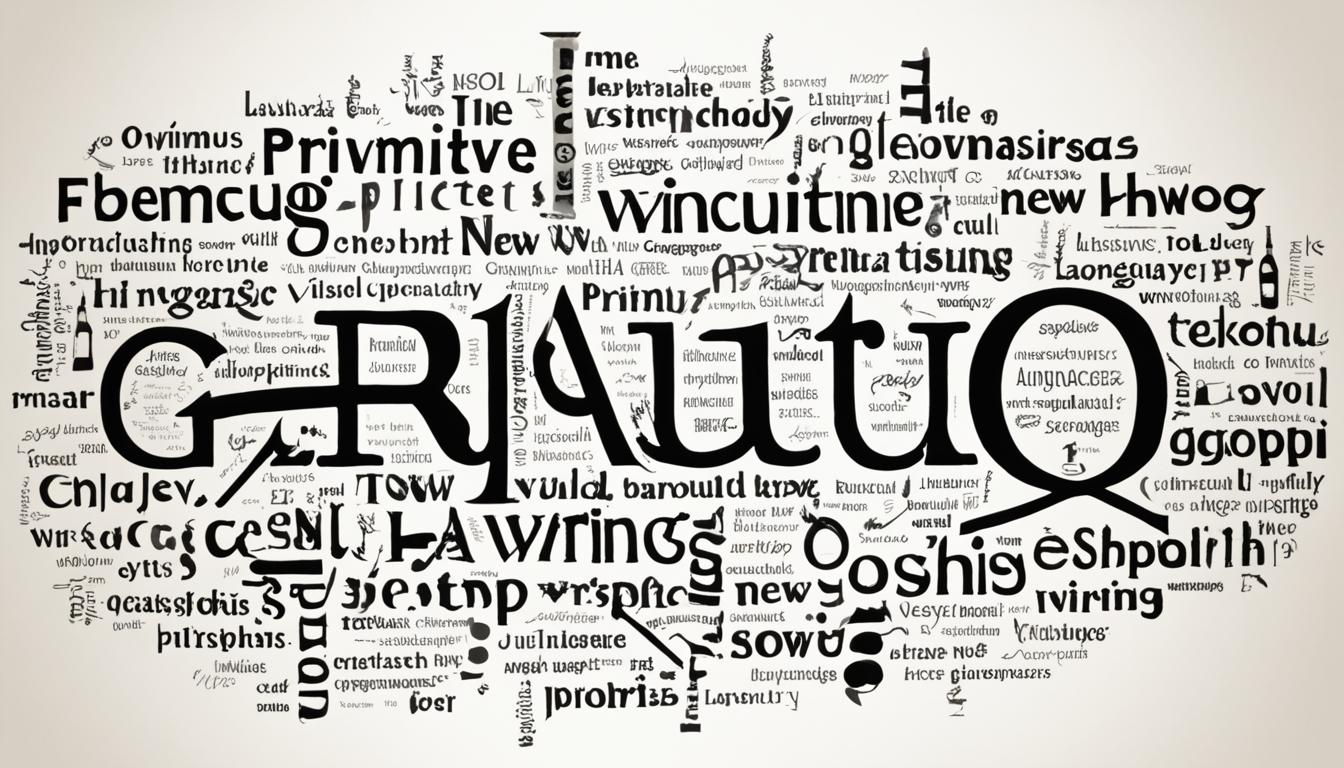Bet ya didn’t know that **irony** and **sarcasm** pack a punch in how we talk? These language tricks pop up in lots of cultures and tongues, spicing up humor, jabs, and social chit-chat. Grasping the nuances of irony and sarcasm in various languages is key for smooth and **fun cross-cultural chats**.
Key Takeaways:
- Irony and sarcasm are present in multiple languages and cultures.
- Understanding their subtleties is crucial for effective cross-cultural communication.
- Irony and sarcasm convey humor, criticism, and social commentary.
- Cultural factors heavily influence the interpretation and impact of sarcasm.
- Open dialogue and education play a vital role in promoting effective cross-cultural communication.
Is Irony Universal?
There is an ongoing discussion among linguists and researchers about the universality of irony and sarcasm across different languages. While some argue that irony is a selected trait in language, others view it as a cultural phenomenon. This debate is at the core of a broader argument about theories of communication and how people convey meaning.
Irony and sarcasm play a significant role in communication, allowing individuals to convey humor, criticism, and social commentary. However, the question remains: are these linguistic phenomena universally understood and appreciated?
Despite cultural differences in the affinity for irony, no cultural group has been found to completely lack the capacity to produce and understand irony. This suggests that there may be an evolutionary benefit to sarcasm and irony, regardless of cultural context.
Irony and sarcasm are part of a broader system of communication that allows people to express themselves in sophisticated and nuanced ways.
Understanding irony and sarcasm requires a certain level of cultural fluency and linguistic proficiency. While some cultures may use irony more frequently and skillfully than others, it does not mean that those who do not heavily rely on irony lack the capacity to grasp its meaning.
To delve deeper into the concept of universality in irony and sarcasm, it is essential to consider the cultural and social factors that influence communication styles and expressive norms. The cultural values, beliefs, and traditions of a society shape the way individuals perceive and employ irony.

Culture as a Lens
Cultural phenomenon
Culture acts as a lens through which we interpret and understand irony. Different societies have unique expectations when it comes to communication styles, attitudes towards criticism, and the use of humor. These cultural influences contribute to the varied use and interpretation of irony.
Evolutionary benefit of sarcasm and irony
From an evolutionary perspective, sarcasm and irony may have offered benefits in social interactions. The use of irony can serve as a form of social bonding and group cohesion. Additionally, irony and sarcasm can be effective tools for conveying complex information indirectly or encouraging self-reflection.
Summary
The universality of irony and sarcasm is a complex and ongoing debate. While cultural differences exist in the frequency and skillful use of irony, no cultural group has been found to be completely devoid of understanding irony. The alleged universality of irony suggests an evolutionary benefit and highlights the significance of these linguistic phenomena in daily communication.
Cultural Influences on Sarcasm
Cultural influences play a significant role in shaping the interpretation and impact of sarcasm. Factors such as language structure, social norms, and expressive styles contribute to how sarcasm is perceived and understood across different cultures.
Language structure is a key determinant in the understanding of sarcasm. Languages with direct communication styles, where messages are conveyed explicitly, may struggle to grasp the subtlety and implicit nature of sarcasm. On the other hand, languages that rely on implied meanings and indirect communication may find sarcasm more familiar and natural.
Social norms also play a crucial role in the reception of sarcasm. Different cultures have varying levels of tolerance for criticism and varying expectations of politeness. These norms influence how sarcasm is received and whether it is perceived as humorous or offensive.
Moreover, expressive styles differ across cultures, affecting the interpretation of sarcasm. Cultural norms regarding tone of voice, nonverbal cues, and body language vary, which can lead to potential misunderstandings. For example, a sarcastic remark may be interpreted differently depending on whether a culture values directness or uses subtle nonverbal cues.
To visually illustrate the cultural influences on sarcasm, the following table presents some examples of how language structure, social norms, and expressive styles shape the interpretation of sarcasm in different cultures:
| Culture | Language Structure | Social Norms | Expressive Styles |
|---|---|---|---|
| American | Direct communication Explicit expressions |
Tolerance for criticism Appreciation for wit and humor |
Emphasis on tone and nonverbal cues |
| British | Indirect communication Understated expressions |
Politeness and manners Use of irony and satire |
Dry humor and subtle delivery |
| Japanese | Indirect communication Implied meanings |
Politeness and respect Avoidance of direct criticism |
Subtle gestures and facial expressions |

Understanding the cultural influences behind sarcasm is essential for effective cross-cultural communication. It enables individuals to navigate the nuances of sarcasm and avoid potential misunderstandings. By recognizing and respecting different language structures, social norms, and expressive styles, individuals can foster better cross-cultural understanding and build stronger connections.
Successful Cross-Cultural Sarcasm
Despite the challenges that sarcasm presents in cross-cultural communication, there are instances where it proves to be a bridge between different cultures. In shared global cultures, such as the internet and pop culture, sarcasm is not only widely understood but also appreciated. The emergence of a shared global culture has created a common understanding and familiarity with sarcastic expressions, creating a unique form of communication that transcends cultural boundaries.
Cultural adaptation also plays a significant role in successful cross-cultural sarcasm. As cultures interact and exchange ideas, they inevitably incorporate sarcastic usages from others into their communication styles. This cultural adaptation allows individuals to navigate and understand sarcasm in a cross-cultural context, breaking down barriers and promoting mutual understanding.

These examples illustrate the power of sarcasm in fostering cross-cultural understanding. They demonstrate how shared global culture and cultural adaptation enable individuals from different backgrounds to appreciate and engage in sarcastic communication, regardless of their native language or cultural norms. By embracing sarcasm as a universal language, society can bridge cultural gaps and promote inclusivity.
Sarcasm in Cross-Cultural Communication
In cross-cultural communication, cultural sensitivity plays a pivotal role in effectively navigating sarcasm. Recognizing that sarcasm may not always translate seamlessly across cultures is crucial for building cultural competence and avoiding potential misunderstandings. By adjusting communication styles based on cultural cues and context, individuals can foster mutual understanding and bridge cultural gaps.
Building cultural competence involves actively learning about how sarcasm is used in different cultural contexts. This includes understanding the varying degrees of sarcasm employed, recognizing cultural cues, and seeking clarification when necessary. It requires a willingness to listen, observe, and adapt to different cultural norms and expressions of sarcasm.
“Cultural sensitivity is an essential aspect of cross-cultural communication and it applies to sarcasm as well. Being aware of cultural differences and adjusting our communication style can greatly enhance understanding and prevent unintended offense.” – Dr. Sarah Chen, Cultural Anthropologist
Effectively navigating sarcasm within cross-cultural communication requires balancing cultural sensitivity with open-mindedness. It is essential to not assume that sarcasm will function in the same way across all cultures. Approaching sarcasm with curiosity and respect enables individuals to build meaningful connections and avoid potential pitfalls.
Developing Cultural Competence
The process of building cultural competence involves actively seeking knowledge about sarcasm within different cultural contexts. This can be achieved through various means, such as:
- Engaging in cultural immersion experiences
- Reading literature or academic research on cross-cultural communication
- Taking part in sensitivity training and workshops
- Seeking guidance from cultural experts or consultants
By investing in cultural education and learning how sarcasm is employed within different cultures, individuals can navigate cross-cultural sarcasm more effectively. This understanding allows for more nuanced communication, fostering mutual understanding and respect.
It is important to note that while cultural sensitivity and competence are essential, there may still be instances where misinterpretations or misunderstandings occur. In such cases, seeking clarification and maintaining an open dialogue is key to resolving any potential issues and strengthening cross-cultural relationships.
Cultural Sensitivity in Action
To illustrate the importance of cultural sensitivity in cross-cultural sarcasm, consider the following scenario:
During a business meeting, John, a manager from the United States, makes a sarcastic comment about a mistake made by Ying, a team member from China. Unfamiliar with John’s sarcastic tone, Ying interprets the comment as a serious criticism and feels insulted. Sensing the tension, another team member, Maria, steps in to clarify John’s intention by explaining the use of sarcasm in American communication. This open dialogue and cultural exchange help repair the misunderstanding and foster a healthier work dynamic.
This scenario highlights the importance of cultural sensitivity in avoiding misunderstandings. Through open dialogue and a willingness to address and clarify cultural differences, individuals can navigate sarcasm more effectively. Cultivating cultural sensitivity enables individuals to bridge cultural gaps, strengthen relationships, and promote effective cross-cultural communication.

| Culture | Example of Sarcasm |
|---|---|
| United States | “Great job… not!” – sarcastic praise |
| United Kingdom | “Oh, brilliant idea, Sherlock!” – sarcastic response to a seemingly obvious statement |
| Australia | “Yeah, right. Like that’s really going to happen.” – expressing disbelief through sarcasm |
| Japan | “Oh, forgive my ignorance. Your brilliance truly astounds me.” – using sarcasm to express humility |
The Future of Cross-Cultural Sarcasm
As the world becomes more interconnected, there is an increased global awareness and understanding of sarcasm across cultures. With greater exposure to diverse cultures through media and travel, people are becoming more familiar with the nuances of sarcastic communication styles.
Additionally, the cultural hybridization that occurs as different cultures interact and blend creates opportunities for the emergence of new forms of cross-cultural and hybrid sarcasm. These evolving communication styles reflect the changing dynamics of our global society.
By embracing the diverse perspectives and unique ways of expressing humor and criticism, cross-cultural sarcasm further promotes understanding and appreciation of different forms of communication.
“Sarcasm enriches cross-cultural interactions by adding layers of wit and social commentary.” – Dr. Maria Hernandez, Cultural Anthropologist
Impact of Increased Global Awareness
The increased global awareness of sarcasm fosters a deeper understanding of cultural nuances and promotes more effective cross-cultural communication. When individuals are exposed to diverse forms of sarcasm, they develop a broader perspective and become more attuned to the subtleties of communication in different cultural contexts.
This global awareness can enhance empathy, compassion, and cultural sensitivity, as individuals recognize and respect the diversity of communication styles and meanings behind sarcastic remarks.
“Global awareness of sarcasm encourages open-mindedness and strengthens connections between people from different cultures.” – Emma Thompson, Linguistics Professor
The Emergence of Hybrid Sarcasm
The hybridization of cultures and the continuous exchange of ideas give rise to new forms of cross-cultural sarcasm. As individuals from different backgrounds interact and share their unique linguistic styles, sarcasm adapts and evolves to incorporate elements from various cultures.
This creates an exciting environment where the boundaries of sarcasm are pushed, leading to innovative and unexpected uses of language for humorous and critical expression.
| Culture | Key Elements | Hybrid Sarcasm Example |
|---|---|---|
| American | Sarcasm using irony and satire | “Wow, that meeting was a real *masterpiece* of efficiency.” |
| British | Dry wit and understatement | “I heard you had quite the *interesting* time at the party.” |
| Australian | Poking fun at oneself and others | “Mate, you’ve really outdone yourself this time. *Congrats* on the epic fail.” |

Through cultural hybridization, sarcasm becomes a tool for building bridges between different communities, fostering understanding and mutual appreciation.
In conclusion, increased global awareness and cultural hybridization are shaping the future of cross-cultural sarcasm. As individuals engage with diverse cultures and embrace the nuances of sarcastic communication, they contribute to the rich tapestry of cross-cultural understanding and promote meaningful connections.
The Limitations of Cross-Cultural Sarcasm
While sarcasm has the potential to bridge cultural gaps, it is important to acknowledge its limitations in cross-cultural communication. The risk of misunderstanding is ever-present, as sarcasm that is well-received in one culture may be perceived as rude, offensive, or confusing in another. Cultural sensitivity is crucial when using sarcasm in a cross-cultural context, as varied interpretations and the reliance on nonverbal cues can further complicate understanding.
One of the main challenges in cross-cultural sarcasm is the potential for varied interpretations. Different cultures have unique communication styles and norms that shape how sarcasm is perceived and understood. Sarcasm relies heavily on context and tone, both of which can be interpreted differently in different cultures. What may be seen as humorous in one culture may be seen as harsh or inappropriate in another. This highlights the importance of cultural sensitivity and the need to consider the cultural context carefully before using sarcasm in cross-cultural communication.
“Sarcasm is a linguistic tool that requires a deep understanding of cultural nuances and linguistic barriers to be effectively utilized in cross-cultural communication.”
Linguistic barriers also pose challenges in understanding sarcasm across cultures. Sarcasm often relies on language-specific idioms, wordplay, and cultural references that may not translate directly. Translating sarcasm can be particularly challenging due to the subtleties and nuances involved. The reliance on nonverbal cues, such as tone of voice and facial expressions, further complicates comprehension, especially in written communication or when language barriers are present. To overcome these barriers, it is important to be aware of potential linguistic challenges and strive for clear communication that minimizes ambiguity.
Cultural sensitivity plays a pivotal role in navigating the limitations of cross-cultural sarcasm. By recognizing and respecting cultural differences, individuals can avoid potential misunderstandings and build stronger cross-cultural relationships. It is essential to approach sarcasm with caution, to seek clarification when necessary, and to be open to learning about different cultural perspectives. Cultural sensitivity promotes empathy, understanding, and effective communication, helping to bridge the gaps that linguistic and cultural barriers may present.
To illustrate these limitations, consider the following hypothetical scenario: A person from Culture A, where sarcasm is commonly used to convey humor, engages in a sarcastic remark with a person from Culture B, where sarcasm is less prevalent and can be easily misunderstood. The person from Culture B may interpret the remark literally, leading to confusion and potentially damaging the relationship between the two individuals. This scenario emphasizes the need for cultural awareness and the importance of adapting communication styles to ensure mutual understanding.
In summary, while sarcasm can be a powerful tool in bridging cultural gaps, it is not without its limitations. The risk of misunderstanding, varied interpretations, cultural sensitivity, and linguistic barriers must be taken into account when using sarcasm in cross-cultural communication. By being aware of these limitations and fostering cultural sensitivity, individuals can navigate the complexities of sarcasm in a cross-cultural context and promote effective communication and understanding.
The Role of Education
In the realm of cross-cultural communication, cultural education and sensitivity training play a vital role in navigating the complexities of sarcasm. With the increasing importance of understanding and bridging cultural gaps, individuals must engage in cultural learning to develop the necessary skills for effective cross-cultural sarcasm. By actively listening to how sarcasm is used in different cultural contexts, individuals can enhance their cultural fluency and avoid potential misunderstandings.
Cultural education provides individuals with a deeper understanding of the nuances and subtleties of sarcasm in various cultural settings. It involves learning about the historical and cultural contexts that influence the use of sarcasm, as well as understanding the specific cultural norms and communication styles associated with it. By immersing themselves in the rich tapestry of cultural expressions, individuals can gain insight into the different ways sarcasm is employed and interpreted across cultures.
“Cultural education empowers individuals to bridge the gaps between languages and cultures, fostering empathy and promoting effective communication.”
In addition to cultural education, sensitivity training plays a crucial role in enhancing cross-cultural communication skills. It emphasizes the importance of being aware of cultural differences and respectful of diverse perspectives. Sensitivity training encourages individuals to approach sarcasm with cultural empathy, recognizing that what may be humorous or acceptable in one culture may not be in another. By cultivating sensitivity to cultural nuances, individuals can navigate cross-cultural sarcasm with tact and consideration.
Education, be it formal or informal, opens a pathway to the development of cultural competence. Through ongoing learning and exploration, individuals can expand their awareness and understanding of sarcasm in different cultural contexts. This knowledge can lead to improved cross-cultural communication skills, allowing for smoother interactions and the establishment of deeper connections across cultures.

The Benefits of Cultural Education and Sensitivity Training:
- Enhances cross-cultural understanding and empathy
- Fosters effective communication in diverse cultural environments
- Promotes cultural fluency and adaptation
- Prevents potential misunderstandings and misinterpretations
- Builds bridges between cultures and promotes inclusivity
Ultimately, the role of education in cross-cultural sarcasm is essential for promoting understanding, respect, and effective communication. By investing in cultural education and sensitivity training, individuals can navigate the complexities of sarcasm with confidence and bridge cultural gaps, fostering a more inclusive and harmonious global community.
The Evolving Landscape
The cultural norms surrounding sarcasm are constantly evolving. In one generation, what is considered acceptable or humorous may change in the next. As language and societal values shift, it becomes crucial for individuals and Natural Language Processing (NLP) systems to adapt to these evolving cultural norms in order to navigate sarcasm effectively.
Adapting to evolving cultural norms requires recognizing and addressing linguistic barriers that may hinder understanding. Languages evolve and develop unique linguistic structures, expressions, and contextual cues that shape the interpretation of sarcasm. By acknowledging these linguistic barriers, individuals can gain a deeper understanding of sarcasm across different cultural contexts and avoid potential misinterpretations.
Furthermore, keeping abreast of evolving cultural norms is essential to prevent the perpetuation of stereotypes or inappropriate responses. What may have been considered humorous or acceptable in the past may no longer align with the evolving values and sensitivities of a society. Remaining sensitive to these changes facilitates respectful and effective communication.
Adapting to evolving cultural norms requires continued education and engagement. By staying informed, individuals can continually update their understanding of sarcasm and its cultural nuances, ensuring that their communication remains relevant and respectful.

Recognizing and adapting to evolving cultural norms is an ongoing process that involves actively engaging with cultural and linguistic diversity. By embracing linguistic diversity and contextual nuances, individuals and NLP systems can bridge linguistic barriers and promote effective cross-cultural communication.
Building Bridges Through Communication
Effective cross-cultural communication requires open dialogue and a willingness to learn from one another. Encouraging open dialogue and facilitating cultural fluency can play a pivotal role in promoting understanding and bridging cultural gaps.
Encouraging Open Dialogue
A key aspect of building bridges between cultures is fostering open dialogue. Encouraging individuals to ask questions and engage in discussions about sarcasm can lead to greater understanding and mutual respect. By providing a safe space for open conversations, cultural differences can be explored, and misconceptions can be cleared up, leading to deeper connections and increased cultural competence.
The Importance of Cultural Fluency
Developing cultural fluency is essential in navigating the intricacies of cross-cultural sarcasm. It involves not only understanding the surface-level meanings of words but also grasping the underlying cultural context and nuances. By sharpening communication skills and developing an awareness of cultural norms, individuals can adapt their approach to effectively communicate and comprehend sarcasm in different cultural settings.
“Open dialogue is crucial for building bridges and fostering cross-cultural understanding. By embracing cultural diversity and actively listening to others, we can bridge the gap and find common ground.”
Engaging in respectful and genuine conversations, where individuals actively listen and seek to understand one another, can break down barriers and promote empathy. This not only enhances cross-cultural relationships but also encourages the appreciation of different perspectives and fosters a harmonious global community.

Benefits of Open Dialogue and Cultural Fluency
The benefits of prioritizing open dialogue and cultivating cultural fluency are far-reaching. It leads to increased intercultural understanding, reduced prejudice, and improved cross-cultural collaboration. When individuals develop the ability to effectively navigate and adapt to different cultural communication styles, they can form stronger connections and build bridges of understanding.
| Benefits | Examples |
|---|---|
| Enhanced empathy and understanding | John, an American traveler, engages in open dialogue with local communities during his visit to Thailand. By listening to their perspectives and experiences, he gains a deeper understanding of Thai humor and sarcasm. |
| Improved cooperation and collaboration | Marie, a business executive, engages in cultural fluency training to effectively communicate with her international team members. By developing an understanding of their cultural backgrounds, she fosters stronger teamwork and collaboration. |
| Reduced misunderstandings and conflicts | Carlos, a student studying abroad in Japan, actively participates in language exchange programs and engages in open dialogue with his Japanese classmates. By discussing cultural differences, he avoids misunderstandings and builds meaningful friendships. |
| Cultivation of trust and respect | Alice, a diplomat, regularly engages in open dialogue with international counterparts to promote mutual understanding. By actively listening and respecting different perspectives, she fosters trust and strengthens diplomatic ties. |
By placing an emphasis on open dialogue and cultural fluency, individuals can transcend linguistic and cultural barriers, leading to improved cross-cultural relationships and a more interconnected global society.
Conclusion
Understanding the subtleties of irony and sarcasm in different languages is crucial for effective cross-cultural communication. By recognizing that cultural factors heavily influence the interpretation and impact of sarcasm, individuals can navigate the complexities of cross-cultural sarcasm and foster understanding.
While there are instances where sarcasm bridges cultural gaps effectively, it is important to be culturally sensitive and aware of potential misunderstandings. Sarcasm has limitations in cross-cultural communication, as what may be humorous or acceptable in one culture may not be in another.
Education and open dialogue play a vital role in promoting effective cross-cultural communication and building bridges of understanding. By acquiring cultural fluency and sharpening communication skills, individuals can navigate cross-cultural sarcasm with greater confidence and effectively bridge cultural gaps.
FAQ
What are irony and sarcasm?
Are irony and sarcasm universal across all languages?
How do cultural factors influence the interpretation of sarcasm?
Can sarcasm bridge cultural gaps?
How can I approach sarcasm in cross-cultural communication?
Is there a growing awareness of sarcasm across cultures?
What are the limitations of sarcasm in cross-cultural communication?
How can education play a role in cross-cultural sarcasm?
How does the evolving landscape impact sarcasm in cross-cultural communication?
How can we build bridges through communication in cross-cultural sarcasm?
Are the Subtleties of Irony and Sarcasm Similar to Puns and Wordplay in Different Languages?
Exploring linguistic humor wordplay in different languages reveals the unique ways irony, sarcasm, puns, and wordplay are expressed. While the subtleties may vary, the underlying essence of clever language manipulation remains consistent across cultures, adding depth and nuance to communication.











